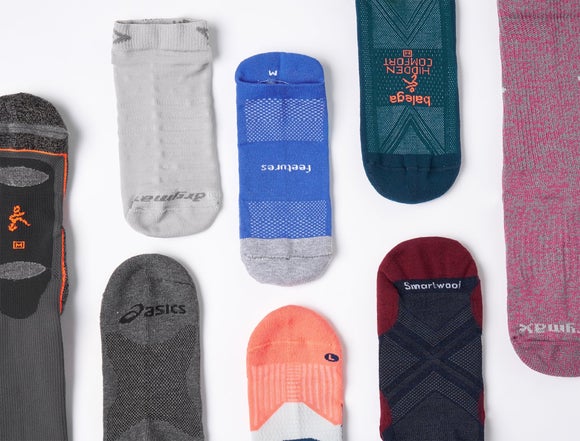How to Choose the Best Running Socks
From a variety of fabrics, lengths, and cushioning, discover the key features of running socks and which one is right for you.

Some runners underestimate the importance of a good pair of running socks, but the right sock can really make the difference between an uncomfortable run and a great run. Pairing poor-quality socks with high-quality running shoes are like using cheap, low-octane gas in a premium sports car. Your performance and ride are bound to suffer. That is why splurging on a pair of running-specific socks is well-worth the investment: happy feet=happy run. The three essential features to look for when choosing running socks are the type of fabric, style of height, and level of cushioning they offer.
Fabric
First off, just say no to cotton. Cotton will absorb moisture instead of wicking it away from your skin, which can cause blisters and chafing when you’re running. Instead, reach for a pair of socks made out of synthetic fabric, like nylon or polyester, or try some Merino wool socks. The choice between synthetic fabric and wool is a matter of personal preference, so try out both types to see which you prefer. Don’t be afraid to try a pair of wool socks. The Merino wool used by brands like LeBent and Swiftwick is nothing like the itchy sweater your mom used to make you wear on cold days. This performance wool is soft and sleek against the skin, and Merino even has antimicrobial properties that help keep foot odors at bay.
Height
Everybody seems to have a favourite sock style. Some people swear by their crew socks, while others won’t leave the house for a run in anything but no shows. Finding the perfect cut for you has to do with how much coverage you want from your sock. Running socks are typically available in five lengths: no show, low cut, quarter, crew, and knee high. Many no show socks have ankle tabs to prevent blisters on the backs of your heels when you’re running. Taller socks are often a better choice for running on the trails or in colder conditions because they provide more coverage. Try out a few styles to find the sock height that works best for you or pick a variety to be better prepared for any condition.
Cushioning
Running socks also come in a range of cushioning options, from ultra-thin socks that offer a barely-there feel to thicker socks that give you plenty of underfoot padding. The biggest factor to consider when selecting the level of sock cushioning is how the thickness of the sock complements the shoes you will be wearing. For example, a super-thin sock will work best inside a snug-fitting racing shoe, while a highly padded sock may fit better with a daily training shoe that allows for more volume. Sock thickness can make the difference between a shoe feeling too snug or too loose. Ultimately, your decision will come down to personal preference, especially considering that once you start running, you will only feel the cushioning of the shoe and not the sock.

